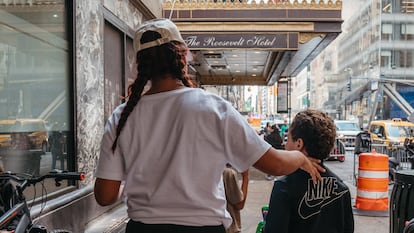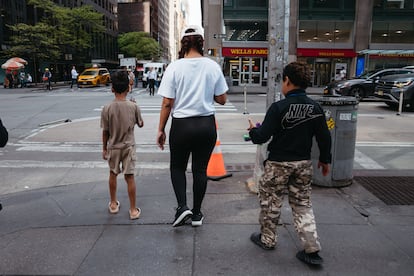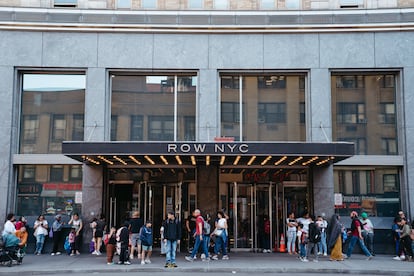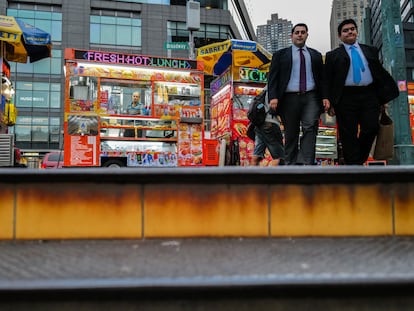Thousands of migrant mothers face closure of New York’s shelter hotels: ‘How much will it cost to rent a small place?’
Without the possibility of obtaining a work permit and fearing deportation, 35,000 families with children still live in the city’s shelters

When she was asked who her children would stay with if she got the job, Valeria, 24, didn’t know what to say. Days later, on a winter morning, she received a message with the results of the culinary program she had applied to, to receive training and a job as a cook in New York City. She’s sure she was rejected because she had no one to look after her two children, ages six and 10. Valeria, who prefers not to give her real name for this story, has been living with her kids in New York’s immigrant shelters for eight months.
They are one of more than 35,000 families with children still living in shelters opened in the city to accommodate thousands of immigrants who arrived in the United States in recent years after fleeing violence or poverty in their home countries. As of March 2025, these families represented 81% of the migrant population in shelters, according to the latest data from the city comptroller’s office, which is no longer updated.
Most of them cannot work formally because they lack legal status and work permits, making leaving the shelters and starting a new life almost impossible. Now, they are also facing the announcement of the closure of 13 shelters, including the renowned Roosevelt Hotel, at the end of June. Valeria and the other mothers living at the Row Hotel, whose closure is not planned, say that social workers have not informed them of what will happen to them when the shelters close.
A representative from Mayor Eric Adams’ Office of Immigrant Affairs stated via email that immigrant mothers in need of a home will always be able to access the shelters that remain open. “The city works to support mothers in shelters through programs and partnerships with nonprofit organizations. We offer childcare options and help mothers connect with jobs,” the office stated.

The city has the Promise NYC program, which provides $700 a week for childcare services to undocumented working mothers, but a survey conducted by the New York Immigration Coalition found that nearly half of women are unaware of the program.
Valeria and her stepmother applied for five other jobs, cleaning hotels, handling food, and caring for the elderly. They were never called back. “They require a work permit, but in reality, the permit isn’t as valuable as they say,” says Valeria. Her stepsister, Marcela, feels the same: speaking English is more important than having legal status. “If you speak English, they get you jobs faster, even if you seek informal work, under the table,” says Marcela.
Valeria recently went to a bank to open a savings account when she discovered her work permit was no longer valid. She had been granted one for two years when she requested an asylum appointment at the border through the CBP One app, a free app created by the Joe Biden administration to help undocumented immigrants enter the country legally, and which Donald Trump eliminated when his administration took office. “They told me my Social Security and my work permit were canceled,” she recalls. Since then, her job search has become more complicated.
An immigrant can apply for a work permit 150 days after applying for asylum, but the process can take up to six months due to delays at the United States Citizenship and Immigration Services (USCIS).
Laura Guzmán, legal advisor at La Victoria Foundation, explains that people who lost the work permit they obtained through CBP One can apply for a new one if they prove they have initiated an asylum application. “What they have to do is go to the Social Services office and prove they are in the asylum process.” The International Refugee Organization has warned that immigrants in this situation remain at risk of deportation, advising in a statement that if they are arrested, they should state that they are afraid of returning to their countries of origin.

Exposed to informal work
Eight years of threats against her son led Regina, 32, to leave Colón, Panama, for the United States. The threats began after the child’s birth, after her partner was involved in a fight with a group of people. “I received many messages threatening to kidnap him,” she explains.
Supported by a cousin who had immigrated to New York City in May 2024, Regina decided to flee her home with her eight-year-old son and 12-year-old daughter on a journey that involved crossing five countries. She had only $3,000. Once at the border, she didn’t wait for an appointment scheduled through the CBP One app. She crossed through Tijuana and ended up in a shelter in San Diego, California, where she filed her asylum claim. A week later, in October 2024, she traveled to New York City and was sent to a shelter in Queens. There she remains waiting for a work permit that has yet to arrive.
Linda, 30, is in the same situation. She had been in Peru for several years, having migrated from her native Venezuela, until her husband began to fall victim to extortion and the couple decided to travel to the United States. The two women are among the 1.2 million asylum seekers who applied for work permits during fiscal year 2024, according to USCIS data.
While they wait, they look for ways to earn money. Linda sells plates of food inside the shelter where she lives in Manhattan. Her husband works informally for a removals company. All they want is to earn enough money to leave the shelter. Regina went to an employment agency where she paid $50 to secure a job cleaning houses, earning $16 an hour, or about $2,000 a month.
“A little place, how much will it cost to rent? $1,500 or $2,000, that’s money we don’t have,” Linda calculates. Anti-immigration raids carried out by Immigration and Customs Enforcement (ICE) also frighten her. She barely leaves the shelter, which is both a prison and her only respite. “Just like you saw me at the hotel, I’m just walking around, with the food cart.”
Sign up for our weekly newsletter to get more English-language news coverage from EL PAÍS USA Edition
Tu suscripción se está usando en otro dispositivo
¿Quieres añadir otro usuario a tu suscripción?
Si continúas leyendo en este dispositivo, no se podrá leer en el otro.
FlechaTu suscripción se está usando en otro dispositivo y solo puedes acceder a EL PAÍS desde un dispositivo a la vez.
Si quieres compartir tu cuenta, cambia tu suscripción a la modalidad Premium, así podrás añadir otro usuario. Cada uno accederá con su propia cuenta de email, lo que os permitirá personalizar vuestra experiencia en EL PAÍS.
¿Tienes una suscripción de empresa? Accede aquí para contratar más cuentas.
En el caso de no saber quién está usando tu cuenta, te recomendamos cambiar tu contraseña aquí.
Si decides continuar compartiendo tu cuenta, este mensaje se mostrará en tu dispositivo y en el de la otra persona que está usando tu cuenta de forma indefinida, afectando a tu experiencia de lectura. Puedes consultar aquí los términos y condiciones de la suscripción digital.
More information
Archived In
Últimas noticias
Most viewed
- Sinaloa Cartel war is taking its toll on Los Chapitos
- Oona Chaplin: ‘I told James Cameron that I was living in a treehouse and starting a permaculture project with a friend’
- Reinhard Genzel, Nobel laureate in physics: ‘One-minute videos will never give you the truth’
- Why the price of coffee has skyrocketed: from Brazilian plantations to specialty coffee houses
- Silver prices are going crazy: This is what’s fueling the rally










































